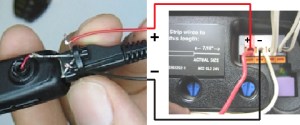
They say all’s fair in love and war – trust us, you don’t have to tell these guys twice.
With the war in Libya raging on, the rebels have turned to anything and everything to help give them the upper hand. Engineers and engineering students have put aside their work and studies to become the architects of the Libyan revolution. In a school playground-cum-weapons facility people from all walks of life work together creating powerful weapons from scrap parts.
[Rajab], the group’s chief weapons engineer, used to drive trucks for a living. Now he is directing his fellow fighters on how best to re purpose scrap materials and recovered military weaponry into effective killing machines. As you can see in the video below, everything is fair game. Their creations range from pickup trucks fitted with recovered fighter jet machine guns, to a Power Wheels chassis that has been converted into a remote controlled machine gun turret.
It’s amazing the things that can be produced with some scrap materials and a bit of ingenuity.
Continue reading “Libyan Rebels Turn Toys Into Weapons Of War”
















